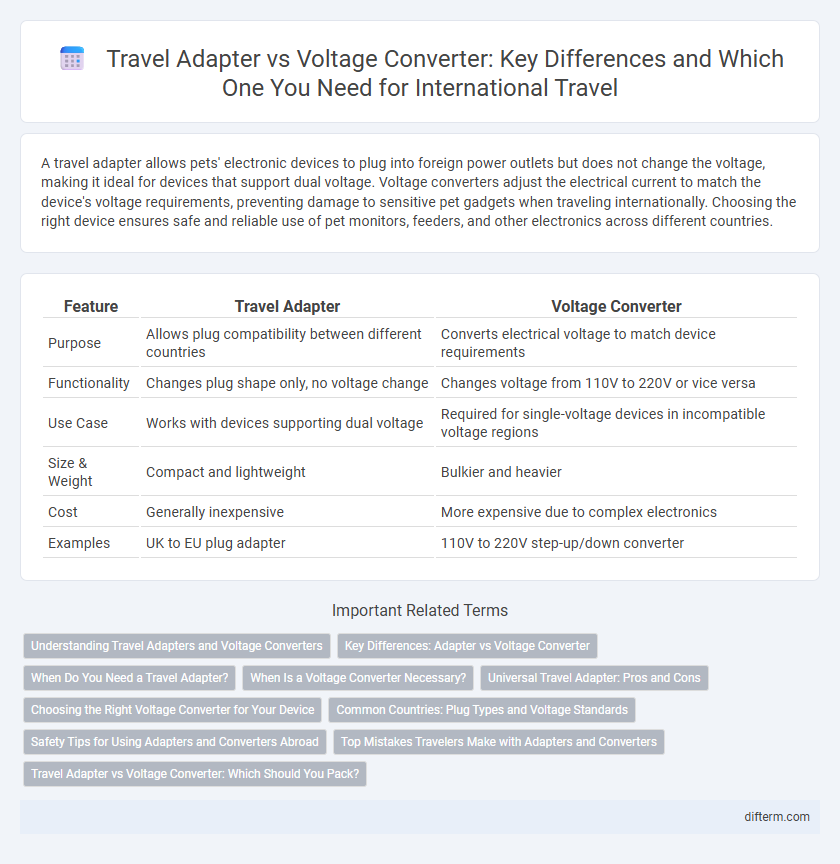A travel adapter allows pets' electronic devices to plug into foreign power outlets but does not change the voltage, making it ideal for devices that support dual voltage. Voltage converters adjust the electrical current to match the device's voltage requirements, preventing damage to sensitive pet gadgets when traveling internationally. Choosing the right device ensures safe and reliable use of pet monitors, feeders, and other electronics across different countries.
Table of Comparison
| Feature | Travel Adapter | Voltage Converter |
|---|---|---|
| Purpose | Allows plug compatibility between different countries | Converts electrical voltage to match device requirements |
| Functionality | Changes plug shape only, no voltage change | Changes voltage from 110V to 220V or vice versa |
| Use Case | Works with devices supporting dual voltage | Required for single-voltage devices in incompatible voltage regions |
| Size & Weight | Compact and lightweight | Bulkier and heavier |
| Cost | Generally inexpensive | More expensive due to complex electronics |
| Examples | UK to EU plug adapter | 110V to 220V step-up/down converter |
Understanding Travel Adapters and Voltage Converters
Travel adapters enable compatibility between different plug shapes worldwide, allowing devices to physically connect to foreign power outlets. Voltage converters modify electrical output, adjusting voltage levels to prevent damage to appliances not designed for local power standards. Choosing between a travel adapter and a voltage converter depends on your device's voltage requirements and the destination country's electrical system.
Key Differences: Adapter vs Voltage Converter
A travel adapter allows you to plug your devices into foreign outlets by changing the plug shape but does not alter the electrical voltage, making it suitable for devices compatible with local voltage. In contrast, a voltage converter transforms the electrical current from one voltage to another, enabling the safe use of devices designed for different voltage standards. Choosing between an adapter and a voltage converter depends on your device's voltage compatibility and the electrical standards of your destination country.
When Do You Need a Travel Adapter?
A travel adapter is needed when your electronic devices have plugs that do not match the power outlets in your destination country, allowing physical connection but not changing voltage. It is essential when countries use different plug shapes but share compatible voltage standards, such as 230V in Europe versus 120V in North America. Understanding the difference between plug compatibility and electrical voltage helps travelers avoid damage to their devices and ensures safe and efficient charging abroad.
When Is a Voltage Converter Necessary?
A voltage converter is necessary when traveling to a country with a different electrical voltage than your device's rated input to prevent damage and ensure proper operation. Most modern electronics like smartphones and laptops are dual voltage, requiring only a travel adapter, but appliances such as hair dryers or electric kettles often need a voltage converter. Checking the device's voltage rating and the destination country's voltage standard, typically 110V or 220V, determines if a converter is essential for safe use.
Universal Travel Adapter: Pros and Cons
Universal travel adapters provide a versatile solution for connecting electronic devices to various plug types worldwide, making them essential for international travelers. However, they do not convert voltage, which means using high-voltage appliances without a voltage converter can damage devices or pose safety risks. Choosing between a universal travel adapter and a voltage converter depends on the traveler's device requirements, power compatibility, and destination voltage standards.
Choosing the Right Voltage Converter for Your Device
Choosing the right voltage converter depends on your device's wattage and voltage requirements to ensure safe and efficient operation abroad. Travel adapters only change the plug shape and do not convert voltage, so a voltage converter is necessary when your device's voltage differs from the destination's supply, typically 110V or 220V. Prioritize a converter with the appropriate wattage capacity and built-in safety features to protect sensitive electronics like laptops, cameras, and smartphones during international travel.
Common Countries: Plug Types and Voltage Standards
Travel adapters enable compatibility with various plug types across common countries such as the US (Type A/B, 120V), UK (Type G, 230V), and Australia (Type I, 230V), ensuring your device fits local sockets. Voltage converters are necessary when your device's voltage rating differs from the country's standard, for instance, using 110V appliances in Europe's 220-240V regions. Understanding plug types and voltage standards helps travelers avoid device damage and ensures smooth operation across destinations worldwide.
Safety Tips for Using Adapters and Converters Abroad
Use travel adapters and voltage converters that match the electrical specifications of your destination to prevent damage to devices and reduce fire risk. Always check the wattage rating of your converter to ensure it can handle your appliance's power requirements safely. Avoid using cheap, unverified adapters and converters, as they can cause electrical hazards, and consider investing in models with built-in surge protection for enhanced safety.
Top Mistakes Travelers Make with Adapters and Converters
Many travelers mistakenly assume that a travel adapter also converts voltage, leading to damaged electronics when plugging devices into incompatible power sources. Using a voltage converter without understanding the required wattage can cause overheating or device failure, especially with high-power appliances. Choosing the correct tool by checking your device's voltage range and the destination's electrical standards prevents costly errors and ensures safe, reliable operation abroad.
Travel Adapter vs Voltage Converter: Which Should You Pack?
A travel adapter allows you to plug your devices into foreign outlets by adjusting plug shapes, while a voltage converter changes the electrical voltage to suit your device's requirements. Travel adapters are essential for compatibility with different plug types, but voltage converters are necessary when your device's voltage rating does not match the local power supply, typically in regions with 110V versus 220V systems. Knowing your device's voltage tolerance and the destination's electrical specifications helps determine whether to pack a travel adapter, a voltage converter, or both.
travel adapter vs voltage converter Infographic

 difterm.com
difterm.com